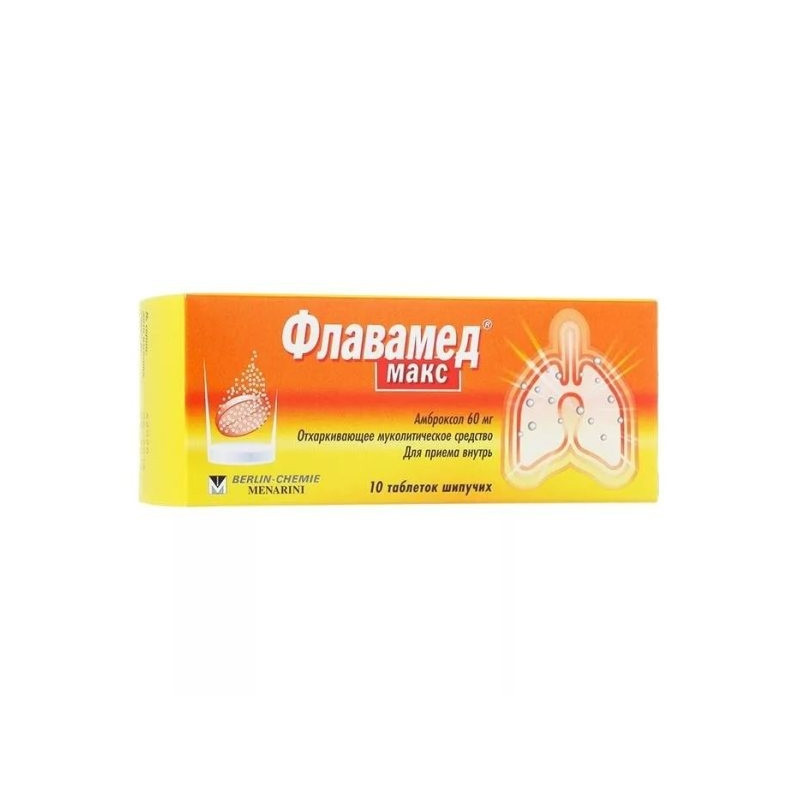



 All payments are encrypted via SSL
All payments are encrypted via SSL
 Full Refund if you haven't received your order
Full Refund if you haven't received your order
Ambroxol
Active ingredient: Ambroxol hydrochloride - 60.00 mg;
excipients: anhydrous citric acid - 846.90 mg, sodium bicarbonate - 298.00 mg, sodium anhydrous carbonate - 71.00 mg, sodium saccharinate - 9.00 mg, sodium cyclamate - 45.00 mg, sodium chloride - 20, 00 mg, sodium citrate - 0.70 mg, anhydrous lactose - 110.00 mg, mannitol - 180.00 mg, sorbitol - 29.00 mg, cherry flavoring - 30.00 mg, simethicone - 0.40 mg.
Expectorant mucolytic agent. Ambroxol is an active N-demethylated metabolite of Bromhexine. Possesses sekretomotorny, sekretolitichesky and expectorant action. Stimulates the serous cells of the glands of the mucous membrane of the bronchi, increasing the content of mucous secretion and, thus, alters the disturbed ratio of serous and mucous components of sputum. Ambroxol increases the content of mucous secretion and the release of a surfactant (surfactant) in the alveoli and bronchi. Increases motor activity of the ciliated epithelium, increases mucociliary transport of sputum.
On average, when taken orally, the effect occurs after 30 minutes, the duration of action is 6-12 hours, depending on the size of a single dose.
Acute and chronic diseases of the respiratory tract, accompanied by impaired secretion and transport of sputum:
Impaired motility of the bronchi and increased secretion of mucus (for example, in rare ciliary syndrome dyskinesia); renal failure and / or severe liver failure; peptic ulcer and duodenal ulcer, including in history; II and III trimesters of pregnancy.
Disorders of the digestive system
Sometimes: nausea, stomach pain, vomiting
Violations of the skin and subcutaneous tissue
Very rare: severe skin reactions such as Lyell's syndrome and Stevens-Johnson syndrome.
General disturbances and local reactions
Sometimes: allergic reactions such as skin rash, swelling of the face, shortness of breath, itching, fever
Very rarely: severe allergic (anaphylactic) reactions up to shock
With the combined use of ambroxol and antitussive drugs that suppress the cough reflex, due to the weakening of the cough reflex, there may be a risk of stagnation in the bronchi.
Increases bronchial secretions in Amoxicillin, cefuroxime, Erythromycin and Doxycycline.
Inside It is recommended to take after meals. Dissolve the pill in a glass of water at room temperature, immediately drink the resulting solution.
Unless otherwise prescribed by a doctor, the following doses are recommended:
Adults and children over 12 years old: 1/2 pill of Flavamed® max 3 times a day (which corresponds to 90 mg of ambroxol hydrochloride / day) for the first 2-3 days, then 1/2 pill of Flavamed® max 2 once a day (which corresponds to 60 mg of ambroxol hydrochloride / day).
If necessary, adults can take 1 pill of Flavamed® max 2 times a day (which corresponds to 120 mg of ambroxol hydrochloride / day).
In patients with renal insufficiency and / or severe liver failure, the drug should be taken with longer intervals between doses or in reduced doses.
The duration of use is set individually, depending on the evidence and the course of the disease. Usually, Flavamed® max is taken no more than 4-5 days, longer use requires an appeal to a doctor.
Symptoms: short-term anxiety, diarrhea, nausea, vomiting.With a significant excess dose of the drug (more than 25 mg / kg / day) may decrease blood pressure, salivation.
Treatment: artificial vomiting, gastric lavage in the first 1-2 hours after taking the drug, taking fat-containing products, symptomatic therapy.
There is evidence of the occurrence in very rare cases of skin reactions (such as Stevens-Johnson syndrome, toxic epidermal necrolysis) with the use of ambroxol. If an allergic reaction occurs, you should immediately stop using the drug and consult a doctor.
In severe renal failure (creatinine clearance less than 30 ml / min), the risk of accumulation of ambroxol metabolites formed in the liver must be taken into account.
Mucolytics can damage the mucosal barrier of the gastrointestinal tract, so Ambroxol should be used with caution in patients with peptic ulcer and duodenal ulcer, including in history.
In order to maintain the secretolytic action of the drug Flawamed® max, during the period of use of the drug, it is necessary to ensure the ingestion of a sufficient amount of fluid.
In patients with asthma, Ambroxol may increase cough.
One effervescent pill of Flavamed® max contains 126.5 g of sodium, which must be taken into account for patients on a low-sodium diet.
The drug Flavamed® max contains sorbitol (sorbitol) and lactose,therefore, its use in patients with hereditary fructose intolerance, hereditary intolerance to galactose, lactase deficiency, or malabsorption syndrome of glucose and galactose is contraindicated.
Information for patients with diabetes mellitus: 1 pill contains 29 mg of sorbitol, which corresponds to 0.0024 bread unit (HE).
Effervescent tablets.
